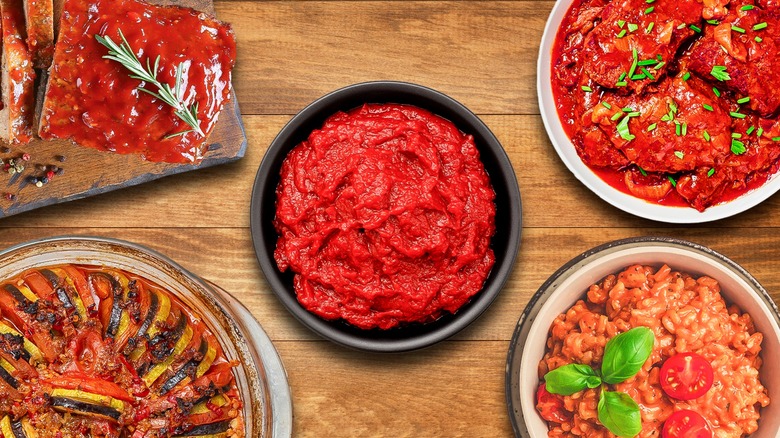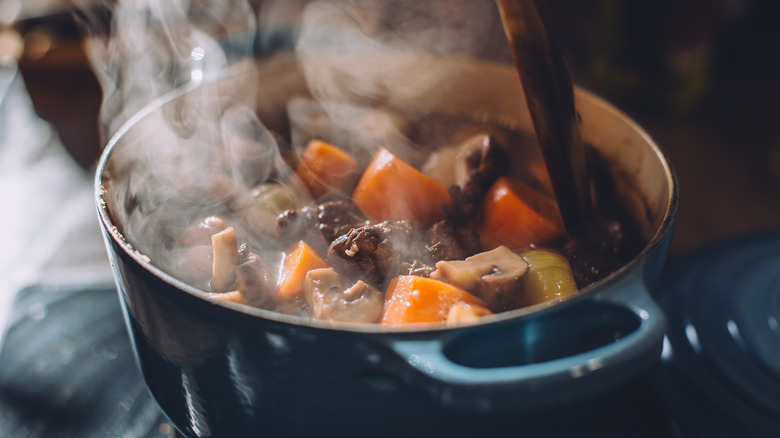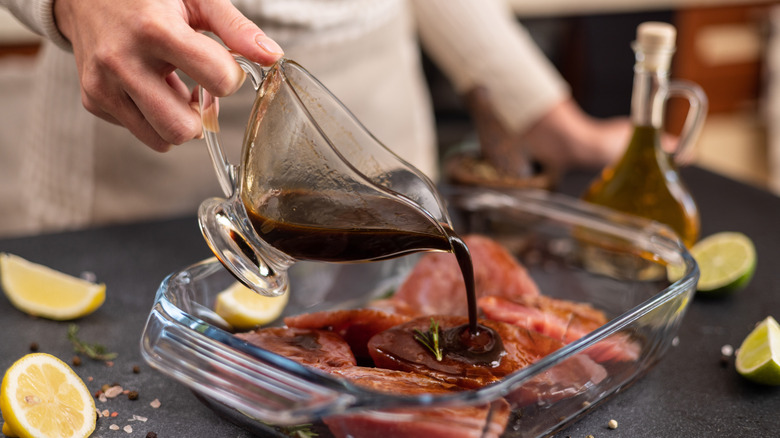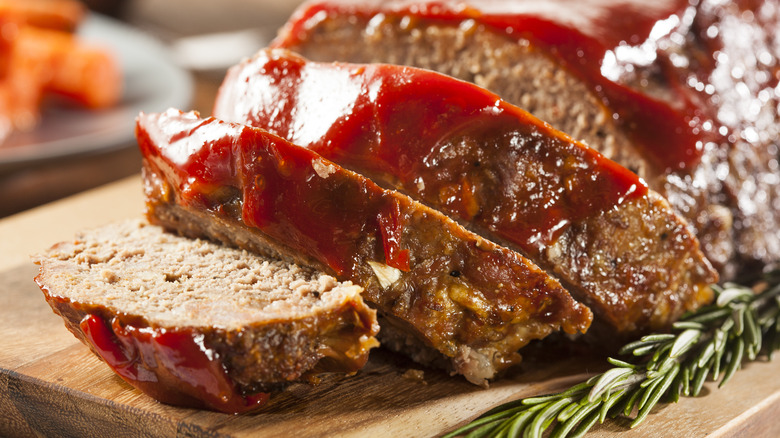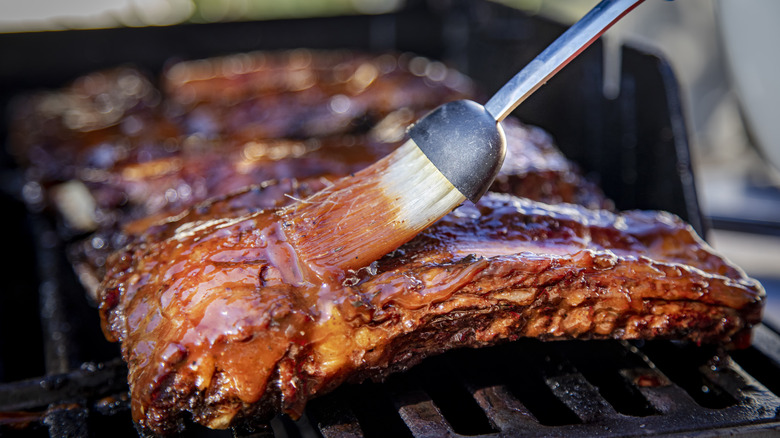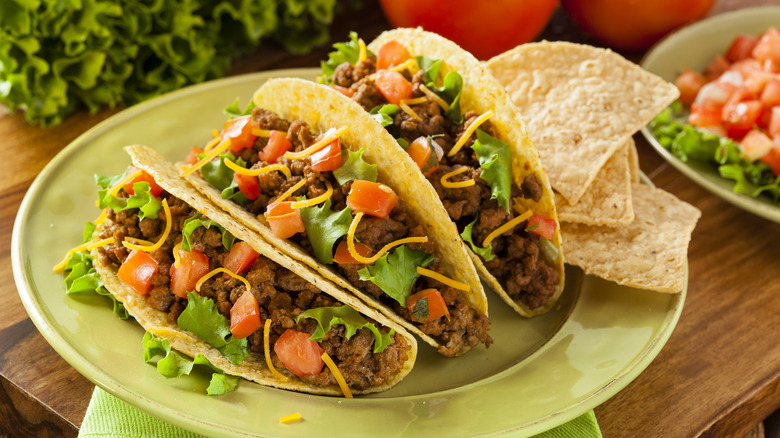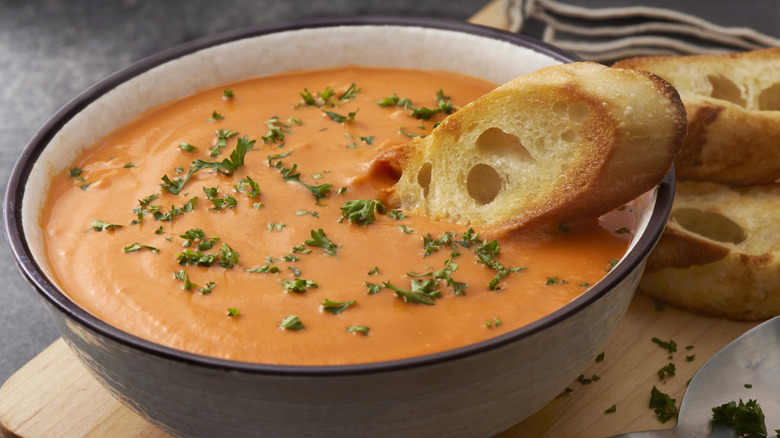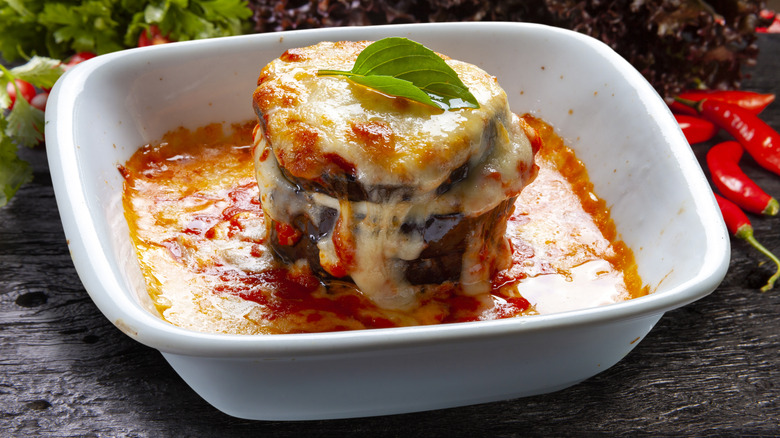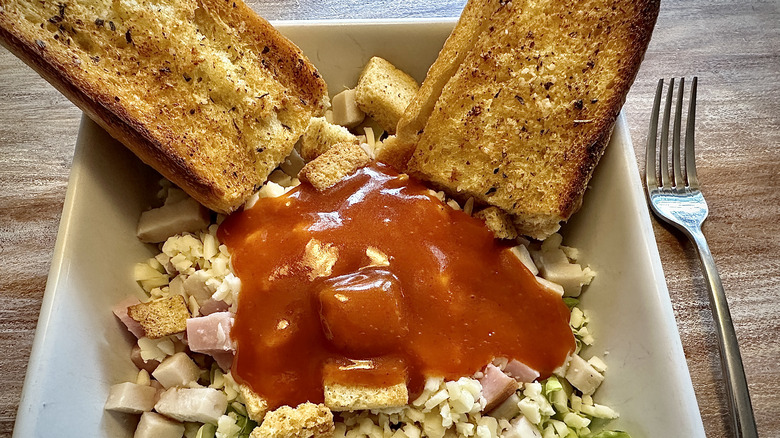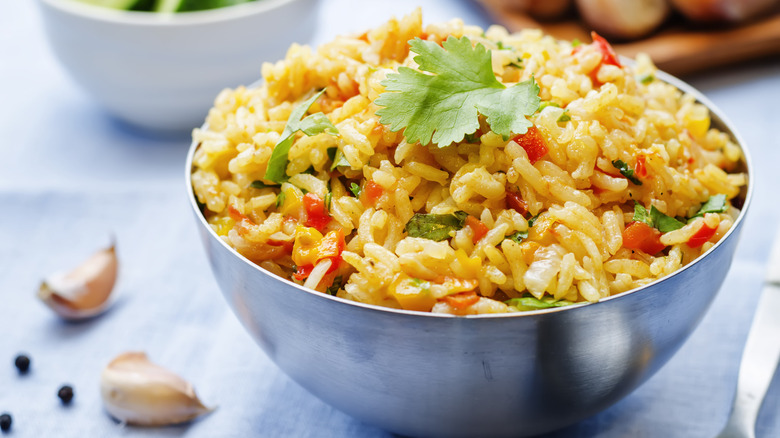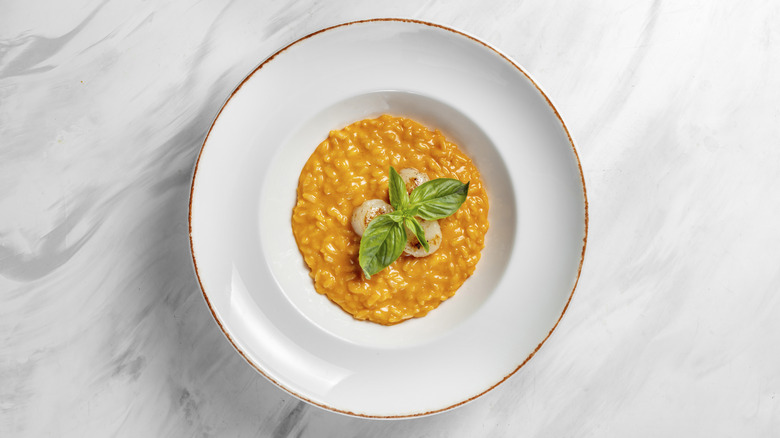13 Ways To Use Tomato Paste You Should Try ASAP
Tomato paste is an ingredient that most of us probably bypass in day-to-day cooking if we're being honest. Often associated with Italian cuisine, tomato paste helps add body and richness to entrées, yet it tends not to be as widely used as its more popular counterparts, tomato sauce or diced tomatoes. Even so, it may surprise you to know that tomato paste can indeed hold its own when it comes to a multitude of dishes, many of which aren't always associated with its use. We've consulted with several culinary experts in hopes of enlightening you on even more ways to harness that familiar tube of tomatoey deliciousness for good. We've picked the brains of the pros — from executive chefs to event planners — to get the lowdown on how exactly tomato paste can be used to render top-notch results in ways outside of the typical pasta and pizza sauce scheme.
Ready to learn all there is to know about using tomato paste in the kitchen? Join us as we dive into 13 ways to use tomato paste that you should try ASAP.
1. Hearty stews and braises
Using tomato paste to enhance stews and braises is an excellent way to elevate flavor. Daniel Meursing, founder and CEO of Premier Staff, has worked alongside several chefs for VIP events in Hollywood and concurs that using tomato paste in this way is almost always a great idea. "Its umami-rich taste complements the flavors of the meat and vegetables, creating a depth that will have your guests yearning for more," he says.
When adding tomato paste to stews and soups, you generally want to add a little bit at a time — one or two tablespoons can often do the trick. "A small amount can add a robust, savory depth that makes the dish more satisfying," says Nic Vanderbeeken, executive chef at Aperitif Restaurants.
As for braising meat, tomato paste will not only deepen flavors but will also provide other benefits. "I love adding tomato paste to braising liquids for meats," Vanderbeeken tells us. "It caramelizes beautifully, enhancing the overall flavor and giving the dish a richer color." Speaking of braised meat, we want you to know that using tomato paste when braising works perfectly with recipes like red wine-braised beef short ribs. To utilize tomato paste here, simply sauté onion before adding garlic and a bit of the paste. Once the tomato paste starts to stick to the bottom of your pot, pour in the red wine or stock for braising.
2. Flavorful marinades
This recommendation may seem a bit unconventional as many marinades tend to feature the traditional lemon, garlic, and oil schtick. Nevertheless, according to our experts, tomato paste is a wonderful ingredient to add to marinades, especially those for meats like chicken or beef.
To pull it off, you'll want to combine tomato paste with a variety of ingredients. Ken Tobby, a food scientist writing for the Organic Solace blog, provides a bit of insight when it comes to elevating the flavor of your meat. "To make a zesty, tasty marinade, mix [tomato paste] with olive oil, vinegar, garlic, and your preferred herbs." Aperitif Restaurants Executive Chef Nic Vanderbeeken offers yet another mouthwatering combination to try the next time your entrée is in need of a flavorful touch. "For a savory marinade, I combine tomato paste with soy sauce, garlic, and a touch of honey. It's perfect for marinating chicken or beef before grilling," he says.
So what exactly is the role of tomato paste when marinating meat? Because of the acidity in the tomatoes, this concentrated paste works as a tenderizer. This means that tougher cuts will benefit from its use, which is one reason you may consider marinating meats like steak in tomato paste. Its bold flavors also work to enhance the taste of whatever you're marinating, especially when combined with aromatics, herbs, and other seasonings.
3. Savory meatloaf
Some of you may already be familiar with this tip, but for those of you who aren't, allow our experts to fill you in. Tomato paste actually works as a fantastic addition to meatloaf as it serves as a more potent and less sugary alternative to traditional ketchup. "Mixing tomato paste into meatball or meatloaf mixtures gives the meat a moist texture and enhances its savory taste. It acts as a great binder as well," Chef Nic Vanderbeeken notes.
Writer Ken Tobby informs us that spreading a bit of plain tomato paste over the top of your meatloaf before baking can make a delicious glaze, though we'll warn you that doing so may prove to be a bit more of a change than you anticipate. Remember that tomato paste is concentrated and packs umami flavors, which can give a different vibe than ketchup on meatloaf.
Thus, if you like the sweetness of ketchup but still want to benefit from the depth of flavor that tomato paste brings, we'd recommend you mix a tablespoon or two of tomato paste into your standard meatloaf ingredients and use ketchup on top (along with a bit of seasoning) as a glaze. This will allow you to enjoy the sweetness of ketchup while also harnessing the robust and savory qualities of the tomato paste.
4. Tasty entrée sauces
Adding a bit of tomato paste to certain types of sauces can really amp up the flavor in a rich, robust, and unexpected way. As our experts suggest, tomato paste can be used as a backdrop to several types of sauces beyond traditional pasta entrées.
Instead of adding tomato paste to your classic spaghetti or pizza sauce, try mixing it with different spices to slather over meat. "Mixing tomato paste with brown sugar, vinegar, and spices creates a delicious glaze for roasted vegetables or meats, adding a perfect balance of sweet and savory," chef Nic Vanderbeeken shares.
Ken Tobby chimes in with his own recommendation: "Combine tomato paste, vinegar, brown sugar, mustard, and spices to make a homemade barbecue sauce. Simmer until it thickens, and use it to baste your favorite grilled meats." On that note, we'd like to add that most barbecue sauces you'll find are tomato-based, though different types feature their own twist. Vinegar-based Memphis-style barbecue sauce often features a noticeable tang, while other tomato-forward barbecue sauces, like the unique flavorings found in a Kansas City-style barbecue sauce, err on the thick and sweet side. Either way, tomato paste can serve its purpose as a flavorful foundation whether you're looking for a basic homemade barbecue sauce recipe or an easy barbecue sauce designed for ribs.
5. Spicy taco fillings
If you're a fanatic when it comes to good taco recipes, you probably already know that adding a bit of tomato sauce to your taco meat can elevate its flavor. What you may not know is that tomato paste can serve much the same purpose, giving your tacos an even more pronounced and concentrated flavor — provided that you use it correctly, that is.
"Sauté onions and garlic, then add ground meat and tomato paste, along with chili powder, cumin, and paprika," recommends Ken Tobby of Organic Solace. To this mixture, you may consider adding water to help thin things out, or, better yet, a bit of beef broth to capitalize on the flavor of the meat. Want to thicken things up? Add cornstarch to help make your taco filling more substantial without altering the taste.
We should also mention that you can use tomato paste to deepen the flavors of homemade taco sauce if you wish. With both tips combined, you'll cook up unbelievably flavorful tacos made possible by easy-to-use umami-flavored tomato paste. Simple!
6. Steamy homemade soups
Like stews, homemade soups can also benefit from the rich and potent taste of tomato paste. As Daniel Meursing of Premier Staff puts it, "A touch of tomato paste can elevate even the simplest of soups, adding a depth of flavor that lingers on the palate. From creamy tomato bisques to hearty vegetable broths, a spoonful of this vibrant concentrate can work magic."
There are several soup types you can use this handy condiment in, and, as usual, our experts are here to get you the details. "For a deep umami flavor, include a tablespoon of tomato paste in your soups such as lentil soup or minestrone," suggests Ranveer Brar, chef and owner of Kashkan Restaurants in Dubai and a judge on several seasons of "MasterChef India." Ken Tobby recommends using tomato paste for another classic: tomato soup. "To get a quick tomato soup, mix tomato paste with cream, broth, and seasonings. Simmer until heated through, then [stir] for a smooth, creamy texture," he says.
Of course, the fresh taste of tomatoes won't always lend itself as naturally to certain soups, so use your best judgment here. Still, for soups with a beefy base or creamy consistency, tomato paste often works to amplify flavors while lending a burst of tomato that may improve your next homemade soup dish for the better.
7. Sweet and savory condiments
Condiments are great to have on hand for dressing sandwiches, but if we're honest, store-bought condiment ingredients aren't always the best. For this reason, you may instead consider using tomato paste to make your own condiments at home for a rich and flavorful sauce that just might taste better than store-bought.
According to Ranveer Brar of Kashkan Restaurants, you can create a spread for your next sandwich or wrap by adding a bit of tomato paste to mayonnaise or yogurt. He even suggests using tomato paste by itself on your next sammie if you feel so inclined. In addition, chef Nic Vanderbeeken recommends making your own ketchup, using only a handful of ingredients for an amazing dip for dunking fries. "When making homemade ketchup, I use tomato paste to get the right thickness and intensity of flavor. It's a great base to build on with other spices and ingredients," he says.
8. Satisfying vegetarian dishes
Tomato paste also works wonders with vegetables, making them stand out. "You can use tomato paste to boost the flavor of vegetarian dishes such as vegetable casseroles, stuffed peppers, or ratatouille. It adds umami and depth to plant-based recipes," Ken Tobby says.
Chef Ranveer Brar takes it up a notch with specifics on other vegetarian entrées that help the flavor nuances in tomato paste shine through best. "Bake eggplant or zucchini after applying a coat [of] tomato paste on their surfaces to give them a savory twist full [of] taste," Brar says. In addition, adding a bit of tomato paste to other familiar yet mundane veggies helps them take on a new and more exciting nature. "For a healthy side dish that quickens your cooking process, sauté spinach or kale with a little garlic plus tomato paste," Brar explains.
You may find that certain vegetarian recipes, such as Eggplant Parmesan, call for tomato sauce instead of tomato paste. In these cases, it's best to dilute your tomato paste before substituting it for tomato sauce in your recipe. To do this, simply mix one part water with one part tomato sauce, then forge ahead with the recipe as directed for a robust depth of flavor.
9. Flavorful dressings and dips
If you love flavorful dressings and dips, this one's for you. According to our experts, you can create some pretty astounding dipping sauces with tomato paste. Chef Nic Vanderbeeken suggests using an unsuspecting yet common ingredient as a base before adding a bit of tomato paste. "I like blending tomato paste with Greek yogurt, garlic, and herbs for a tangy and flavorful dip that's great with vegetables or pita chips," he says.
Vanderbeeken also recommends adding a touch of tomato paste to traditional dips you already use. "Stirring a bit of tomato paste into hummus can add a unique twist. It introduces a deeper flavor and a vibrant color, making your hummus stand out," he says.
You can even create a rendition of tomato-flavored hummus at home without needing to grab a store-bought variety. Start with this basic lemon hummus recipe. You'll need a can of chickpeas, tahini, olive oil, lemon, a few seasonings, and tomato paste (along with a food processor). Follow the recipe as directed, and at the end, add some tomato paste, mixing it in a little bit at a time, until it reaches the flavor you prefer. This is a simple way to take a basic recipe and infuse it with umami tomato flavor.
10. Enhanced rice and grains
Bring added flavor to your rice with little to no effort by including some tomato paste. Chef Ranveer Brar explains that you can infuse rice — or even quinoa — with savory tomato flavors by simply mixing a bit of tomato paste in as you toast your rice with oil or butter first before cooking the grains in liquid until tender.
And while many authentic Mexican rice recipes we've seen feature tomato sauce and broth, you could easily substitute the sauce with a bit of tomato paste to create an equally delicious Mexican-inspired version of rice. Of course, there are plenty of other opportunities to use tomato paste in rice. Indian cuisine often features these flavors as do certain tomato and rice side dishes often eaten in the South. This jollof rice recipe with tomato paste is a tasty West African dish. Just remember that a little goes a long way when it comes to using tomato paste — a couple of tablespoons will usually more than suffice when flavoring rice.
11. Flavor bomb in burgers
In light of the earlier meatloaf tip, it makes total sense that tomato paste would serve as a great addition in hamburgers. Daniel Meursing fills us in on this show-stopping tip you can use the next time you're hungry for beef. "Craving a juicy, flavorful burger or a batch of mouthwatering meatballs?" he asks. "Tomato paste is the secret ingredient that can take your recipes to new heights. Incorporate it into the meat mixture for an extra burst of umami goodness."
The amount of tomato paste you'll need to utilize will depend on the amount of meat you're using, but in general, a tablespoon or so per pound and a half is a good guideline to start with. You'll want to mix it in with the ground beef along with any other seasonings before cooking. As always, feel free to adjust the amount by using more or less in accordance with your preference for tomato flavor.
Oh, and just so you know, it isn't only burgers and meatballs that'll benefit from the paste. You can take entrées like Salisbury steak to new heights using this unassuming ingredient as well. In fact, Bobby Flay's Salisbury steak recipe naturally calls for tomato paste, making it so that you don't have to guess when it comes to adding the right amount.
12. Rich compound butter
Compound butter is a wonderful blend of all sorts of ingredients often used to add richness and flavor to meats and veggies. And while compound butter typically features herbs, garlic, lemon, and, well, butter, it can also feature zestier options like tomato paste. "I like making compound butter with tomato paste, garlic, and herbs," chef Nic Vanderbeeken says. "It's perfect for spreading on bread or melting over grilled meats and vegetables."
We did a little research, and adding tomato paste to butter isn't as foreign of a concept as it may seem. Often referred to as tomato butter, this yummy spread utilizes the lusciousness of butter combined with the pleasant umami taste of tomato paste to provide you with an option perfect for a variety of culinary uses.
What's more is that this delicious spread easy to make — simply combine a cup of room-temperature butter with a couple of tablespoons of tomato paste along with your choice of seasonings. Use plastic wrap to roll your butter into a log, and chill before using. It's really that simple, and yet it yields delectable results.
13. Luscious risotto
Risotto has a reputation for being a delightfully simple way to enjoy rice in the creamiest, most decadent way, but adding a surprise ingredient to this already delightful dish really works to take the flavors up and over the top.
Our experts have once again come through to share their unique tips for flavoring risotto using none other than tomato paste. "Stir a spoonful of tomato paste into your risotto as it cooks," Ken Tobby recommends. "It will add a deep tomato flavor and a beautiful color that pairs well with various ingredients." Before adding your tomato paste, we've also found that it helps to sauté it with a bit of garlic and onion beforehand, as this will enhance the overall flavor of the dish. There are plenty of recipes for Creamy Tomato Risotto out there, though some call for tomato sauce rather than the paste. As mentioned before, you can dilute the tomato paste at a 1:1 ratio if you need to substitute the sauce with the paste.
In need of options with which to pair your newfound tomato-essenced risotto? According to chef Nic Vanderbeeken, pairing it with sundry vegetables and protein options is a great place to start. Crispy chicken thighs, sizzling sausages, grilled shrimp, or asparagus often make fantastic options.
